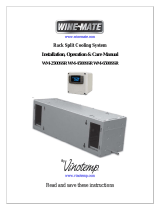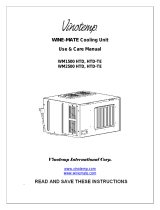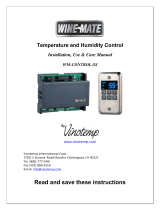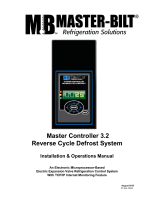Page is loading ...

WINE-MATE Split System
Installation, Operation & Care Manual
VINO2500SSH, 4500SSH
VINO6500SSH, 8500SSH
V
V
i
i
n
n
o
o
t
t
e
e
m
m
p
p
I
I
n
n
t
t
e
e
r
r
n
n
a
a
t
t
i
i
o
o
n
n
a
a
l
l
C
C
o
o
r
r
p
p
.
.
w
w
w
w
w
w
.
.
w
w
i
i
n
n
e
e
m
m
a
a
t
t
e
e
.
.
c
c
o
o
m
m
READ AND SAVE THESE INSTRUCTIONS

- 1 -
TABLE OF CONTENTS
Important Safety Information…..........................................2
Feature Description…………………………….……………..3
Cellar Construction.…………………………….……………..6
Installer’s Instruction…………….…..….……..……………..7
Temperature Control & Humidity Adjustment.………….15
Care Guide…………………………………………………….20
User’ Troubleshooting…….………………………………...21
Customer Support……………………………………………23
Warranty……………………………………………………….24

- 2 -
Important Safety Information
• DO NOT USE A GROUND FAULT INTERRUPTER (GFI).
• A DEDICATED 20 AMP CIRCUIT IS HIGHLY RECOMMENDED.

- 3 -
Feature Description
• Wine-Mate split cooling systems VINO2500-8500SSH are designed and
used to provide a cold temperature between 50~65
°F for a properly
insulated wine room at a normal environment.
• The wine room will maintain humidity of 50~70% RH even when the
environment becomes dry and humid. These temperatures and humilities
are optimized for long term storage of wine.
• SSH units consist of a condensing unit and an evaporator unit, and they
are connected by a liquid line and an insulated suction line.
• SSH condensing units can be located away from the evaporator units and
wine cellars as far as 50 feet, which will bring you quiet operation.
• The SSH evaporator units are designed to provide chilled air to wine
rooms through ducts and can be located up to 25 ft away to reduce noise.
The dimensions and capacities are specified as follows:
MODEL
EVAP UNIT
L”xH”xW”
COND UNIT
L”xH”xD”
Btu/h
(55/90
°F)
CFM
BOTTLE
CAPACITY
(55/75
°F)
REFRIGERANT
ELECTRICAL
EVAP UNIT/
COND UNIT
WEIGHT(lb)
EVAP UNIT/
COND UNIT
VINO-
2500SSH
WM-25SFCH
22.5x14.375x
15.875
WM-250SCU
18x14x12
2500/220
250
cu ft
1200
bottles
R134a
115V-60HZ-
0.8A / 115V-
60HZ-5.7A
30/40
VINO-
4500SSH
WM-45SFCH
25.125x16.375
x22.875
WM-450SCU
18x14x12
4500/380
1000
cu ft
4500
bottles
R134a
115V-60HZ-
1.8A / 115V-
60HZ-6.9A
39/60
VINO-
6500SSH
WM-65SFCH
25.125x20.375
x22.875
WM-650SCU
24x17x18
6500/490
1500
cu ft
6500
bottles
R134a
115V-60HZ-
1.8A / 115V-
60HZ-12A
48/90
VINO-
8500SSH
WM-85SFCH
27.125x22.375
x22.875
WM-850SCU
24x17x18
8500/750
2000
cu ft
8500
bottles
R134a
115V-60HZ-
2.1A / 115V-
60HZ-15A
58/115

- 4 -
Fig. 1.1 WM25-85SFCH Evaporator Unit
Fig. 1.2 WM250-450SCU Condensing Unit

- 5 -
Fig. 1.3 WM650-850SCU Condensing Unit

- 6 -
Cellar Construction
This is only a guide and shall be considered as minimum requirements.
All interior walls and floors shall have a vapor barrier and a minimum of R11
insulation. All exterior walls and ceiling shall have a vapor barrier and a minimum
of R19 insulation. The vapor barrier shall be installed on the warm side of the
insulation. All joints, door frames, electrical outlets or switches and any pipes or
vents that go through the enclosure shall be sealed to prevent air and moisture
leakage into the room. Concrete, rock, and brick are not insulation or vapor
barriers.
Doors shall be of a minimum size, insulated to at least R11 and tightly sealed
with high quality weather stripping. Be sure to seal the bottom of the door and fill
gap between the door’s frame and wall before installing the cap molding.
In order to maintain 55 °F in the wine cellar, the ambient temperature
surrounding the enclosure shall not exceed the temperature of the enclosure by
more than 25 °F. No enclosure wall shall receive direct sun or strong wind.
Lighting shall be of low wattage, with a timer to insure lights are not left on when
the enclosure is not occupied.
The cooling system will not be able to maintain the proper temperature if fresh
moisture-laden air is constantly being introduced to the enclosure. Symptoms of
this condition are; unit runs all the time with only a slight reduction in temperature
and/or water overflows from the unit. Because of the temperature difference
between the inside and outside, very small cracks can allow large amounts of
outside air to enter into the enclosure. Please be aware that moisture can pass
through solid concrete, paint and wood. Often a newly constructed room contains
fresh wood, paint, concrete and other building materials. These materials contain
large amounts of moisture. When placed into operation in this type of
environment, the system will work harder to remove this extra moisture resulting
in increased “run” time.

- 7 -
Installer’s Instruction
Federal law requires that WINE-MATE split cooling systems be
installed by an EPA certified refrigeration technician.
WINE-MATE split system is shipped as components and is ready for use only
after a certified refrigeration technician has properly installed, charged and tested
the system. Proper installation is critical. Vinotemp can only warrant the quality of
the components. The installation and proper operation of the system must be
warranted by the installer. Installation of the system must be done in accordance
with all state and local building codes.
The condensing unit and evaporator unit are connected by a liquid line and an
insulated suction line that are supplied by the installer. These lines must be
properly sized for the distance between the two units. After the units and the lines
are installed, the system must be pressure tested. If no leaks are found,
evacuate and charge system with R134A. Refrigerant amount will vary
depending on the length of line set.
Fig. 2.1 SSH Split System Installation

- 8 -
1. Condensing Unit
• Place the condensing units WM250-850SCU in a properly ventilated
location. If it is not, heat exhausted by the condensing unit will build up
and the cooling system will not operate properly.
• Leave minimum 5 feet clearance for the exhaust side and leave minimum
1 foot clearance for the fresh air intake side.
• Condensing unit shall be elevated to avoid possible flooding and shaded
from direct sun. It shall not be exposed to temperatures higher than 110
°F or lower than 45 °F (optional low ambient kit for 20 °F).
2. Evaporator Unit
• The WM25-85SFCH evaporator units can be installed outside a wine
room.
• Supply and return air flow from the evaporator unit shall be unobstructed
for at least 1 foot.
• There is a gravity drain line so that it can not be installed above the
evaporator unit. Otherwise a condensation pump must be used.
• If the overall duct length is more or less than 50ft, it is necessary to check
the air flow to meet the specified CFM. It may use larger or smaller size
ducts or fan speed control to adjust the system refrigeration performance
to achieve 8-10°F differential between return air and supply air.
3. Air Sensor
• The air sensor is recommended to place in the wine room. If it is in a
return duct, due to the temperature differential the temperature setting
needs to be adjusted in order to maintain the proper wine room
temperature.
4. Refrigeration Piping and Charging
NOTES: ALWAYS USE THE SUPERHEAT AND SUBCOOLING,
PRESSURE READINGS TO CHARGE REFRIGERANT PROPERLY, THE
LISTED CHARGES ARE FOR REFERENCE ONLY.
• The installation order starts from condensing unit (including the receiver),
liquid line filter-drier, moisture-liquid indicator (sight glass), liquid line,
evaporator unit (including liquid line solenoid valve and thermostatic
expansion valve or automatic expansion valve), suction line, and returning
to condensing unit.
• The subcooling at the condensing unit shall be around 10
°F. The charge
may be complete when there are no more bubbles forming in the sight
glass.

- 9 -
• The evaporator’s constant pressure expansion valve is set around 38-
40°F at factory. This pressure setting gives a dew point to maintain the
humidity for storing wine.
• The superheat at the evaporator unit shall be around 9-18°F under low
and high load at 75
°F ambient temperature.
• Low side pressure: 33 psig
• High side pressure: 130 -150 psig at 75 -90
°F ambient temperatures
The line sizes and refrigerant charges are listed as follows.
MODEL
REFRIGERATION
LINES
LIQUID
LINE
SUCTION
LINE
DUCT
DRAIN
LINE
CHARGE
VINO-
2500SSH
< 50 FT 1/4" OD 3/8” OD 8” 7/8” OD
R134a/
20 OZ
VINO-
4500SSH
< 50 FT 1/4" OD 1/2” OD 8” 7/8” OD
R134a/
26 OZ
VINO-
6500SSH
< 50 FT 1/4" OD 5/8” OD 10” 7/8” OD
R134a/
32 OZ
VINO-
8500SSH
< 50 FT 3/8" OD 5/8” OD 10” 7/8” OD
R134a/
38 OZ
5. Pressure, Superheat and Subcooling Readings
NOTES: THE VALVES MUST BE IN THE MIDDLE POSITIONS TO READ
PROPERLY.
Complaint Possible Causes
a. High suction pressure and low head pressure
b. High suction pressure and low head pressure
Low superheat and low subcooling
c. High suction pressure and high head pressure
Low superheat and high subcooling
d. High to normal suction pressure and high head pressure
Low subcooling
e. High suction pressure and high head pressure
Low subcooling
f. High suction pressure and high head pressure
High superheat
g. Low suction pressure and low head pressure
High superheat and low subcooling
h. Low suction pressure and low to normal head pressure
High superheat and high subcooling
i. Low suction pressure and low head pressure
Low subcooling
j. Low suction pressure and low head pressure
Low superheat and low subcooling
k. Low suction pressure and low to normal head pressure
High superheat and normal to high subcooling
l. Low suction pressure and normal head pressure
High superheat and normal subcooling
m. Low suction pressure and high head pressure
a. Compressor may be bad
b. Expansion valve opened, too
much oil
c. Overcharge
d. Non-condensable gas
e. Air restricted, dirty condenser,
bad condenser fans
f. High room temperature, high
evaporator load
g. Undercharge
h. Liquid line restricted after
receiver, solenoid valve
restricted
i. Suction line restricted
j. Air restricted at evaporator,
evaporator iced
k. Evaporator restricted
l. Expansion valve restricted
m. Both evaporator and condenser

- 10 -
High superheat and high subcooling
n. Low suction pressure and high head pressure
High superheat and high subcooling
o. low to normal suction pressure and high head pressure
High to normal superheat and high subcooling
restricted
n. Liquid line restricted before
receiver
o. Condenser restricted
6. Valve Operation
SPINDLE BACK POSITION SPINDLE FRONT POSITION SPINDLE MIDDLE POSITION
Fig. 2.2 Valve Operation
Back Position: Process and manometer port closed for normal operation
Front Position: Main connection to liquid or suction line closed
Middle Position: All ports open for vacuum, charge and measurement

- 11 -
7. Electrical Wiring
Fig. 2.3 VINO2500 & 4500SSH Electrical Wiring Diagram (VTSTAT)
Fig. 2.4 VINO2500 & 4500SSH Wiring Diagram (DIGITAL CONTROLLER)

- 12 -
Fig. 2.5 VINO6500SSH Electrical Wiring Diagram (VTSTAT)
Fig. 2.6 VINO6500SSH Electrical Wiring Diagram (DIGITAL CONTROLLER)

- 13 -
Fig. 2.7 VINO8500SSH Electrical Wiring Diagram (VTSTAT, UJ6220Z)
Fig. 2.8 VINO8500SSH Wiring Diagram (DIGITAL CONTROLLER, UJ6220Z)

- 14 -
8. Use of the adjustable low pressure control (if applicable)
Cut out = 5 psig; Cut in = 25 psig; Differential = 20 psig;
It may need to adjust the setting in the field to get the right cycle time.
Fig. 2.9 Adjustable Low Pressure Control
9. Condensing Unit Troubleshooting
Unit not running
a. Incorrect power supply
b. Incorrect or loose wirings
c. Failed components
d. Liquid refrigerant in the compressor
e. Low pressure switch shutting down the system
a. Check for proper voltage
b. Check all wirings and connections
c. Check start relay, start capacitor, overload
protector, compressor.
d. Call service for OEM information
e. Check for system restriction or low
refrigerant

- 15 -
Temperature Control & Humidity Adjustment
1. Temperature Setting
• Set the temperature at 55 °F for the optimum aging of wine
• On initial start-up, the time required to reach the desired temperature
will vary, depending on the quantity of bottles, temperature setting
and surrounding temperature.
• Allow 24 hours to stabilize the temperature for each new temperature
setting operation
2. Use of the VTSTAT controller
NOTE: Use the dial number for “Medium Temp”
Fig. 3.1 VTSTAT
Fig. 3.2 Default Dip Switch Setting

- 16 -
Dip-switch description (See detail in VSTAT instruction )
1, 2 differential: added to the Set Point, establishes the temperature threshold,
measured by the regulation probe, beyond which the compressor is activated;
3 compressor safety function: OFF - function disabled; ON - function enabled;
4 temperature display: OFF - displayed in °C; ON - displayed in °F;
5,...,8 duration of defrost/defrost termination temperature: if the defrost sensor is
utilized, these dip-switches select the defrost termination temperature, otherwise
they select the defrost duration;
9 type of defrost: OFF - resistance defrost, ON - hot gas defrost.
1) Set Point
Rotate the circular selector in correspondence with the arrow placed nearby. The
selector represents 14°F to 68°F (-10°C to +20°C) for medium temperature
models. “10” is the coldest setting, “1” is the warmest. Use the medium temp
setting and place the dial at number 3.
2) Differential
It is possible to modify the differential from 1°F minimum to 12.5°F maximum.
Simply shift the first two dip-switches to the ON or OFF position according to the
wanted value.
3) Defrost management and setting
A defrost can be activated manually, by pressing the “man. def.” button, or
cyclically, the interval set by the “def.intvl” rotary switch at the top left with respect
to Set Point selector. The interval can be selected from 1 to 12 hours in 1 hour
steps. If the selector is positioned on the “0”, the cyclic defrost is disabled.
Note: manual defrost reinitializes the time required for successive cyclic
defrosting. The selections are effective beginning from the successive cycle. For
an immediate effect, it is necessary to turn power to the VTSTAT off for a few
seconds.
It is possible to choose between an electric defrost (the compressor is
deactivated and the defrost relay is activated) and a hot gas defrost (both the
compressor and the defrost relay are activated); The defrost termination, can
take place by time (from 1 to 60 min.) or by temperature (from 0 to 86°F) if the
defrost sensor is utilized for the correct programming). If the defrost sensor is
disconnected, interrupted or breaks down for any reason, the defrost terminates
after a maximum time of 90 minutes if it is resistance-based, or 40 minutes if it is
hot-gas based.
The instrument stores the defrost state every 15 minutes to allow restart after
power loss.
4) Compressor safety function
If the function is enabled, a minimum three minute interval is ensured between
deactivation and successive restart of the compressor.

- 17 -
If the function is enabled, the compressor is not energized for three minutes after
controller power up.
The function is also active in hot-gas defrost mode.
5) LED & Display Messages
1. LED off
2. LED on
3. LED blinking 0.5s on/0.5s off
4. LED blinking 0.5s on/1.5s off
5. Display A1
6. Display A2
1. Compressor and defrost deactivated
2. Compressor energized
3. Defrost activated
4. Sensor fault
5. Regulation probe fault
6. Defrost probe fault
3. Use of the Digital Controller
Fig. 3.3 Digital Controller
1) Display
During normal operating conditions, the display shows the value measured by
the air regulation probe. In case of active alarm, the temperature flashes
alternately to the code alarm.
1.1 LED Functions
1.2 Front Panel Commands

- 18 -
2) Alarm Signals
2.1 Code Description
2.2 Alarm Recovery
Probe alarms P1”, start a few seconds after the fault in the related probe; they
automatically stop a few seconds after the probe restarts normal operation.
Check connections before replacing the probe. Temperature alarms “HA”, “LA”
automatically stops as soon as the temperature returns to normal value. Alarm
“CA” (with i1F=PAL) recovers only by switching off and on the instrument.
3) Temperature Set-Point
3.1 How to see the set-point
1. Push and immediately release the SET key: the display will show the Set-point
value;
2. Push and immediately release the SET key or wait for 5 seconds to display the
probe value again.
3.2 How to change the set-point
1. Push the SET key for more than 3 seconds to change the Set point value;

- 19 -
2. The value of the set point will be displayed and the “°C” or “°F” LED starts
blinking;
3. To change the Set value, push the o or n arrows within 10s.
4. To memorize the new set point value, push the SET key again or wait 10s.
4) Humidity Adjustment
The parameter Fon is used to adjust the humidity in the wine cabinet. The higher
value of Fon, the higher relative humidity will be.
1. Press the Set + keys for 3 sec until the “°C” or “°F” LED starts blinking.
2. Release the keys, then push again the Set + keys for more than 7sec, the
Pr2 label will be displayed.
3. Release the keys, select the required parameter Fon by up or down keys .
4. Press the “SET” key to display its value.
5. Use up or down keys
to change its value.
6. The default value is 0, change high or low value to maintain high or low
humidity.
7. Press “SET” to store the new value.
8. To exit: Press SET + or wait 15sec without pressing a key.
5) Regulation Differential
The parameter Hy is used as intervention differential for set point. Compressor
cut-in is the set-point + Hy, and compressor cut-out is the set-point.
1. Press the Set +
keys for 3 sec until the “°C” or “°F” LED starts blinking.
2. Release the keys, then push again the Set + keys for more than 7sec, the
Pr2 label will be displayed.
3. Release the keys, HY will display immediately.
4. Press the “SET” key to display its value.
5. Use up or down keys to change its value.
6. The default value is 4, change high or low value to result in long high or short
running cycle.
7. Press “SET” to store the new value.
8. To exit: Press SET + or wait 15sec without pressing a key.
6) Defrost Cycle
The parameter IdF is used as interval between defrost cycles.
1. Press the Set +
keys for 3 sec until the “°C” or “°F” LED starts blinking.
2. Release the keys, then push again the Set + keys for more than 7sec, the
Pr2 label will be displayed.
3. Release the keys, select the required parameter IdF by up or down keys
.
4. Press the “SET” key to display its value.
5. Use up or down keys to change its value.
6. 7. Press “SET” to store the new value.
8. To exit: Press SET +
or wait 15sec without pressing a key.
7) Manual Defrost
Push the DEF key for more than 2 seconds and a manual defrost will start.
/





